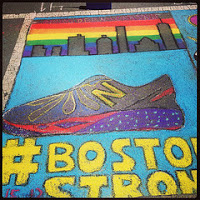 by Joan Rachlin, Executive Director
by Joan Rachlin, Executive Director
Today marks one month since the heartbreaking and horrific Marathon bombings here in Boston. Some things in the city remain unchanged: the ubiquitous springtime walks for worthy charities and important organizations are taking place—safely—each weekend, U-Haul and Budget trucks clog the streets in neighborhoods with high student density as college kids decamp for home and/or jobs elsewhere, and white sails are starting to dot the Charles River.
A lot of things are different, though, from that bright Marathon-morning when the trees were still bare, and excitement and energy were in the air. In the intervening 30 days, magnolias, ornamental cherry trees, dogwoods, and azaleas have bloomed in an almost-defiant sign of the Boston-strong rebirth. Police officers and members of the National Guard are now posted on every block during those above-referenced weekend walks. And, most notably, instead of talking about the highs and lows of Boston sports teams, many, if not most, folks are still talking about the attacks and their aftermath.
 The intervening month has also brought certain truths into sharp relief in every sense of that word. I am relieved that the FBI and local law enforcement were able to collaborate so quickly and effectively, and relieved that they were able to bring an end to the surreal and violent chapter before any more lives were lost. I am relieved that the Boston Athletic Association (BAA) had taken the lessons of 9/11 so seriously that they had annual disaster drills and were thus prepared for the unthinkable. I’m relieved that the first responders were so well-trained, so courageous, and so quick-thinking, and that the fatalities were not as numerous as they might otherwise have been. And I’m relieved, and enduringly grateful, that those BAA personnel and first responders had one of the best, if not the best, networks of trauma centers and hospitals to which wounded could be sent.
The intervening month has also brought certain truths into sharp relief in every sense of that word. I am relieved that the FBI and local law enforcement were able to collaborate so quickly and effectively, and relieved that they were able to bring an end to the surreal and violent chapter before any more lives were lost. I am relieved that the Boston Athletic Association (BAA) had taken the lessons of 9/11 so seriously that they had annual disaster drills and were thus prepared for the unthinkable. I’m relieved that the first responders were so well-trained, so courageous, and so quick-thinking, and that the fatalities were not as numerous as they might otherwise have been. And I’m relieved, and enduringly grateful, that those BAA personnel and first responders had one of the best, if not the best, networks of trauma centers and hospitals to which wounded could be sent.
Although no one says this in a voice higher than a whisper for fear of invoking some ancient evil eye, it is remarkable that not one victim who made it to a hospital that day has died. Given the more than 260 wounded, many of them critically, it is nothing short of a miracle that there were not more fatalities. More miraculous still is the fact that many of the torn and damaged limbs were reattached by the talented and determined transplant and other surgeons in Boston who were fresh off face transplants, hand transplants, and the myriad other transplants that take place daily in our city’s hospitals. Although no numbers are available, it is understood that every limb that could be reattached, was reattached, and the skill demonstrated by every member of those operating teams is a story in itself.
Part of that story originates in battlefield research and other forms of emergency research. Faced with injuries more reminiscent of those sustained in modern day warfare, physicians at Boston-area hospitals were quick to leverage the knowledge that has been gained from battleground trauma in Iraq and Afghanistan. Take for instance the tourniquet—at one point dismissed as an outdated tool—the tourniquet has gained favor in military medicine in recent years and is credited with saving many lives in Boston on that spring afternoon. Years of research and innovation in treating wartime injuries have also resulted in significant advances in prosthetic technology, which will help those individuals who lost one or more limbs maximize their mobility and thus independence.
\The knowledge and advances from which the victims benefited on Marathon Monday have not come easily, however. There are inherent challenges when conducting research on a battlefield or in other emergency settings. Potential harms must be weighed against potential benefits and carefully balanced with protections for those involved. Institutional review boards and/or research ethics committees have grappled with difficult and complicated questions—When it is ethically permissible to waive consent in emergency research? What, if any, other elements of the regulations can be waived when doing research on the battlefield? Where are the boundaries between innovative surgery and experimental surgery in emergency situations?—to find the balance that best protects subjects while advancing lifesaving procedures.
Through the careful review and ongoing oversight of these protocols, the path of progress was paved and led to Copley Square in Boston on Marathon Monday. While the review process is filled with dilemmas and deliberations, the insight gained from such efforts has and will continue to prove invaluable. Research in emergency situations, including on battlefields, will continue to bear fruit in countless other hospitals around the world.
Thank you for your role in advancing ethical research. It is because of the knowledge gained from such studies that I can today send our community’s continued hopes for healing to the bombing victims, who are living testaments to the power and purpose of research.

No comments! Be the first commenter?